1 - North Bridge & Old Manse Walking Tour
2 miles (3.2 km), 45-minutes’ walking time, round-trip, + sightseeing time.
Walking Tour 1 - North Bridge & Old Manse
Note: Construction and improvements to the North Bridge area of Minute Man National Historical Park, carried out in September and October, have been completed, and the North Bridge area is again open to all visitors.
Monument Square
Start at Monument Square, Concord’s equivalent of the town green or common.
The square takes its name from the Civil War Monument, a granite obelisk at its center erected in 1866 to commemorate the sacrifice of Concord men in the Civil War (1861-65).
At the northwestern end of the square is Concord’s Colonial Inn, opened in 1716 and still providing food, drink and lodging to travelers.
Other buildings on the square include the red brick Town House, Concord’s town hall; Holy Family Catholic Church, in the Scandinavian-looking former Universalist church building; that church’s tawny Rectory on the other side of the square; the Holy Family Parish Hall; Corinthian Lodge of the Ancient Free & Accepted Masons; and the First Church of Christ, Scientist.
In the traffic roundabout with the flagpole is a horse-watering trough bearing the date 1888.
Facing Concord’s Colonial Inn, turn right and walk along Monument Street, Concord’s status residential address.
In less than 10 minutes, just after passing Bartlett Hill Road (on the right), you cross the Reformatory Branch Trail for bikes and pedestrians, a component of the Bay Circuit Trail.
Keep the trail in mind. It can be a shortcut to Sleepy Hollow Cemetery on your return walk from the Old North Bridge.
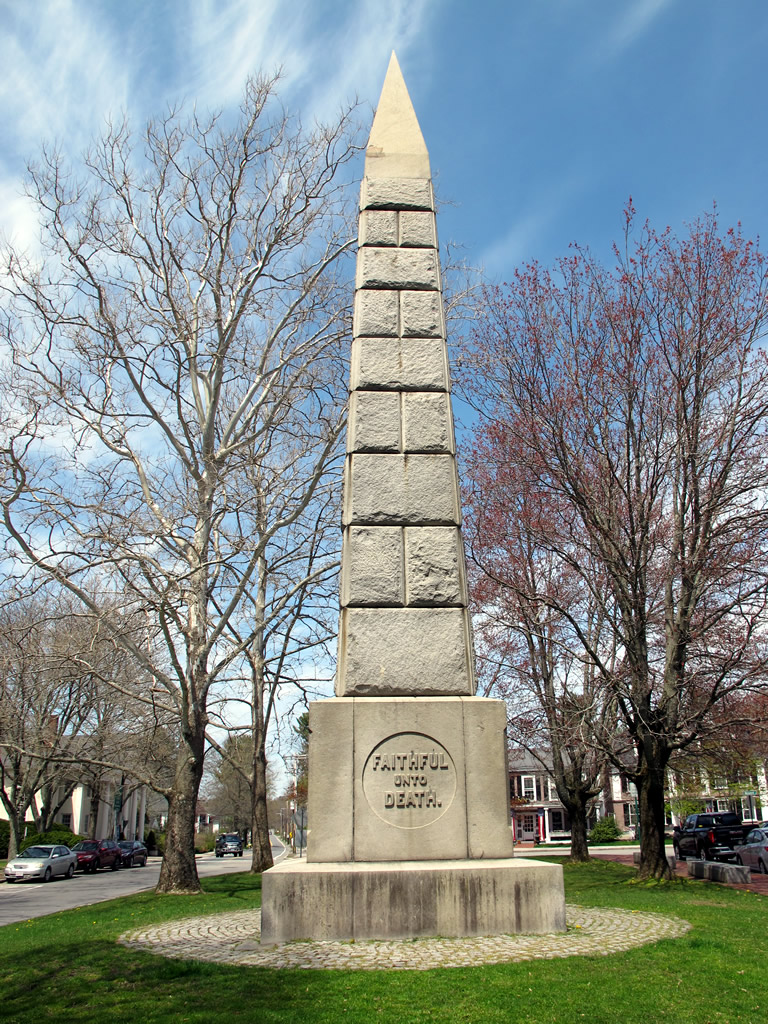
Monument Square & Colonial Inn
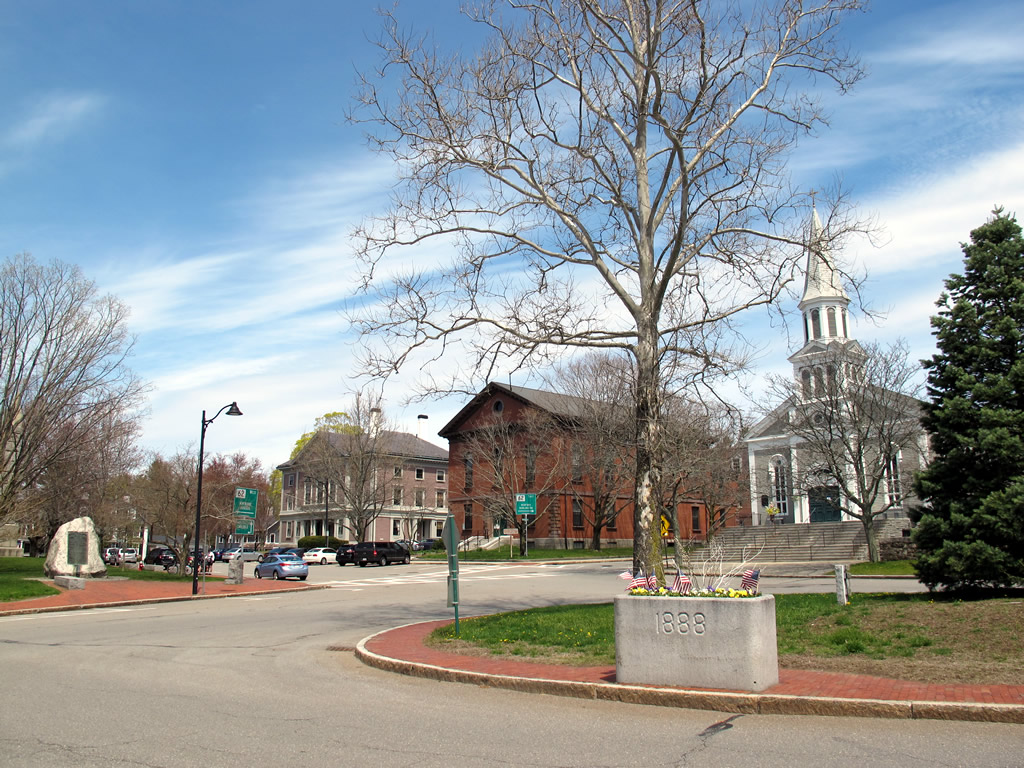
Monument Square
Elisha Jones House & Shed
The yellow house at 242 Monument Street is the Elisha Jones House and Shed, a historic 18th-century structure renowned for a lead ball lodged in the shed wall. Tradition says the ball came from the gun of a Redcoat on April 19, 1775.
Look closely at the shed (to the left of the house), between the door and the window to the left of it, and you can see a small diamond of wood surrounding the hole.
The house and shed are private property, not open to the public.
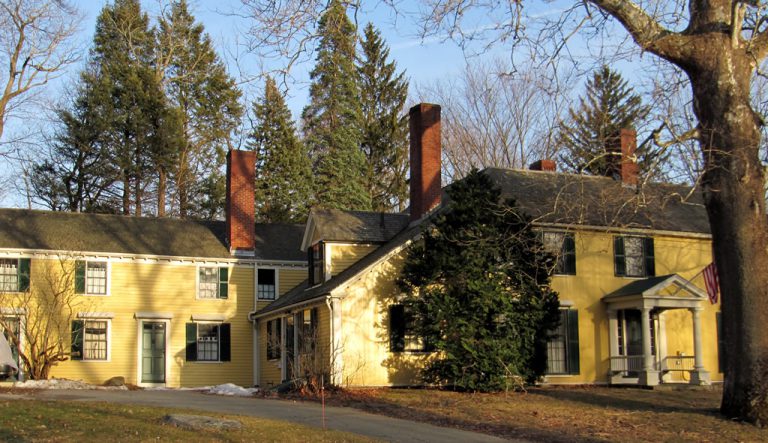
Elisha Jones (Bullethole) House
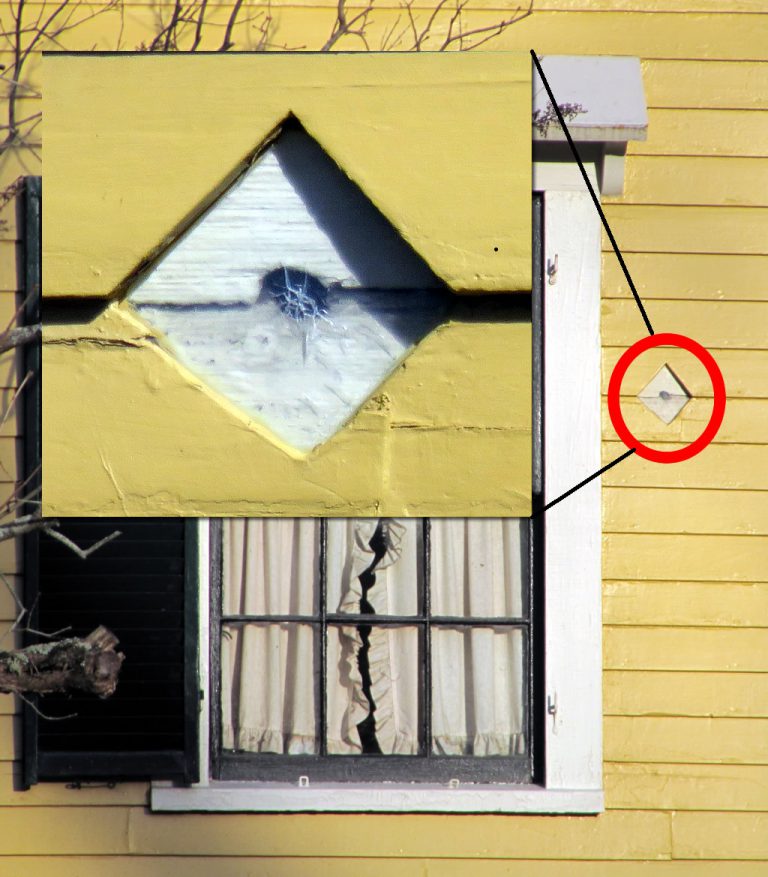
Bullet hole in the Elisha Jones House
The Old Manse
This historic house next to Old North Bridge was lived in by the Emerson family for 169 years except for a three-year period when writer Nathaniel Hawthorne and his bride Sophia Peabody Hawthorne rented it.
Built in 1770 by Reverend William Emerson, the house was relatively new when, on the morning of April 19, 1775, Redcoats marched past it and across the North Bridge on their way to Colonel Barrett’s farm. The Redcoats were looking to destroy colonial militia arms caches.
Reverend Emerson’s grandson, Ralph Waldo Emerson, knew the Old Manse well as a child visiting his grandparents.
Nathaniel and Sophia Hawthorne rented and moved into the Manse just after their wedding. Hawthorne’s residence here gave the shy, reclusive writer material for several later stories.
Now cared for by The Trustees, the house today is filled with the spirit and the mementoes of the Emerson clan, and of Nathaniel and Sophia’s short stay. Your guide will proudly point out where Sophia scratched her name into a windowpane using her diamond wedding ring.
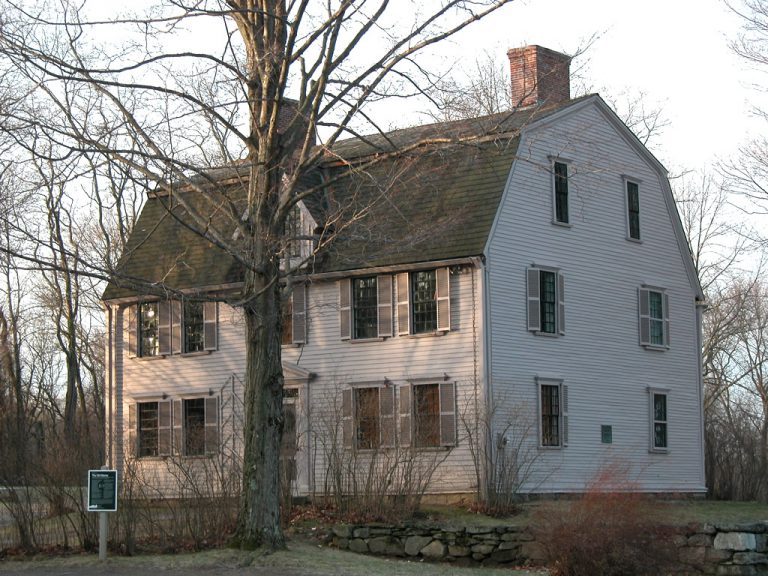
The Old Manse
Old North Bridge
On the morning of April 19, 1775, Concord’s Old North Bridge was the site of the first American victory in the Revolutionary War.
At dawn on the morning of April 19th, 1775, the Lexington Minutemen, far outnumbered, exchanged shots with Regulars on Lexington Green. Minutemen fell wounded and dead, and the Regulars advanced toward Concord and Colonel Barrett’s farm, said to hold an illegal arms cache.
As a task force of Regulars returned from Colonel Barrett’s farm over the North Bridge, they were met by Minuteman companies from Concord and the neighboring towns of Acton, Bedford and Lincoln. Shots rang out, the Minutemen advanced, the British retreated and, victorious, the Minutemen harassed the king’s Redcoats all the way back to Boston.
The small obelisk at the near (east) end of the bridge, was dedicated on July 4, 1837. Look to the left: in the stone wall is a memorial for the British soldiers killed and wounded in the fight here.
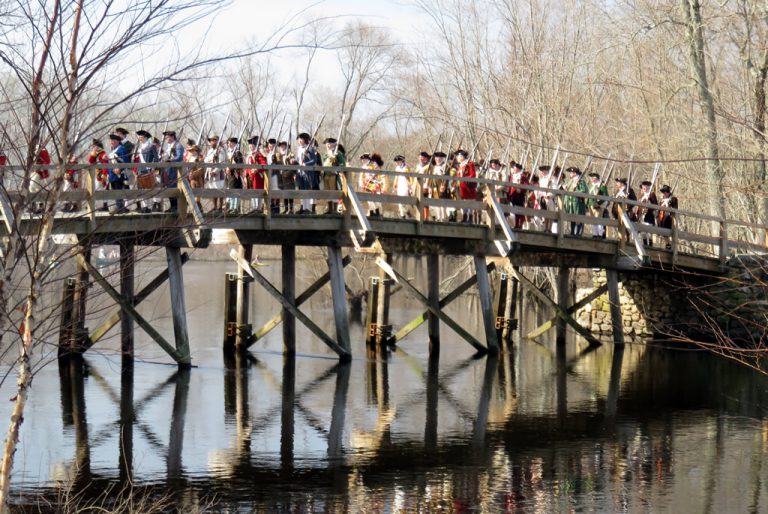
Minutemen march over Old North Bridge
The Concord Minute Man
Cross the bridge over the Concord River to the far side to see Daniel Chester French‘s first important statue, The Minute Man.
(French later sculpted the seated Abraham Lincoln for the Lincoln Memorial in Washington, DC.)
On the statue’s plinth is the first stanza of Emerson’s famous Concord Hymn:
By the rude bridge that arched the flood,
Their flag to April’s breeze unfurled,
Here once the embattled farmers stood
And fired the shot heard ’round the world.
Beyond the statue, follow the sandy path uphill through the meadow to the Buttrick Mansion, now the National Park North Bridge Visitor Center and shop.
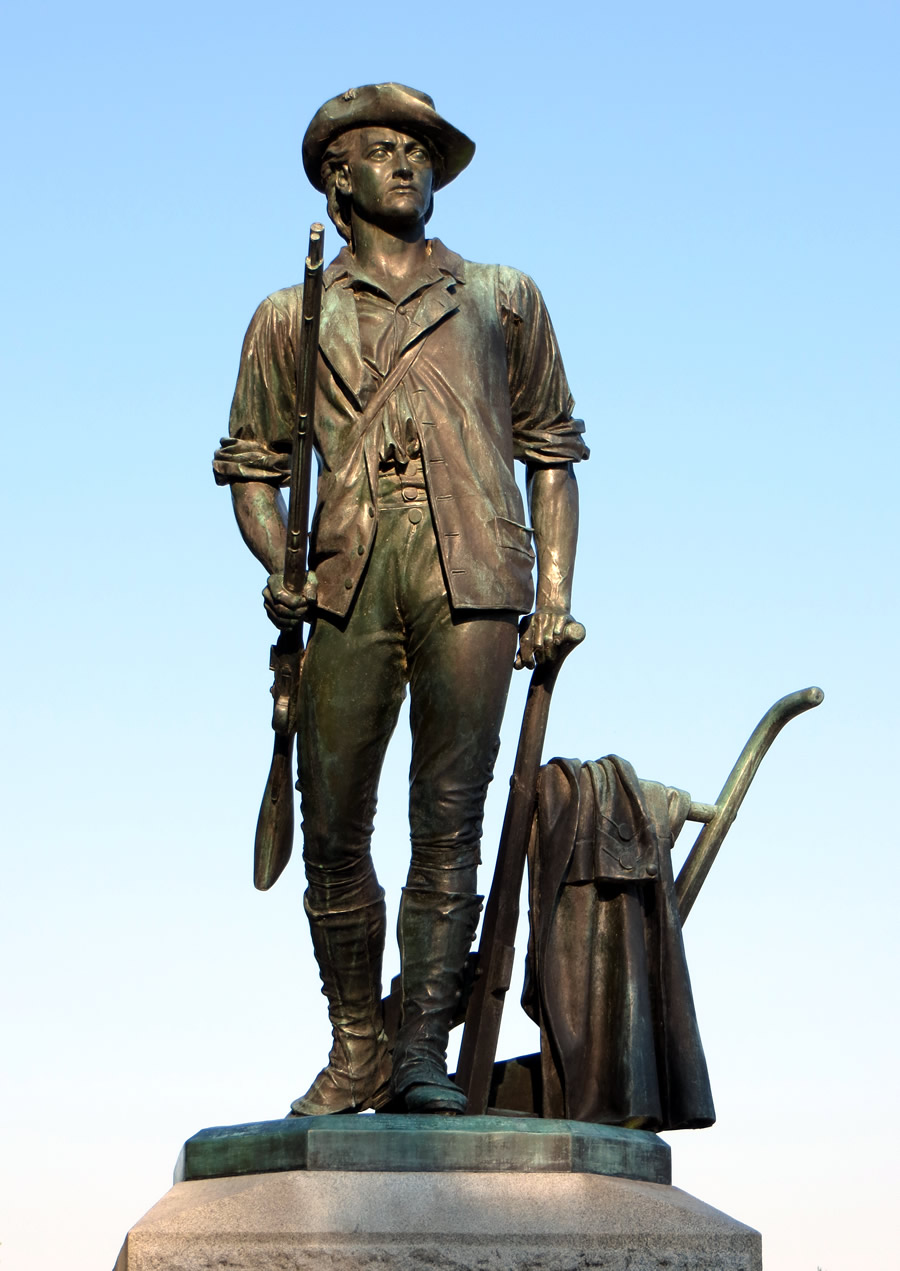
The Concord Minute Man, by Daniel Chester French
Caesar Robbins House
To the north of the Old North Bridge parking area is the restored Robbins House, now Concord’s African-American and Abolitionist History Center.
Born into slavery about 1745, African-American Caesar Robbins fought in the French and Indian War, and in 1776 he participated in the march to Fort Ticonderoga and the fortification of Dorchester Heights that drove the British from Boston.
Freed from slavery by his military service, he lived on his farm in Concord. His children Peter and Susan were the first residents of the Robbins House.
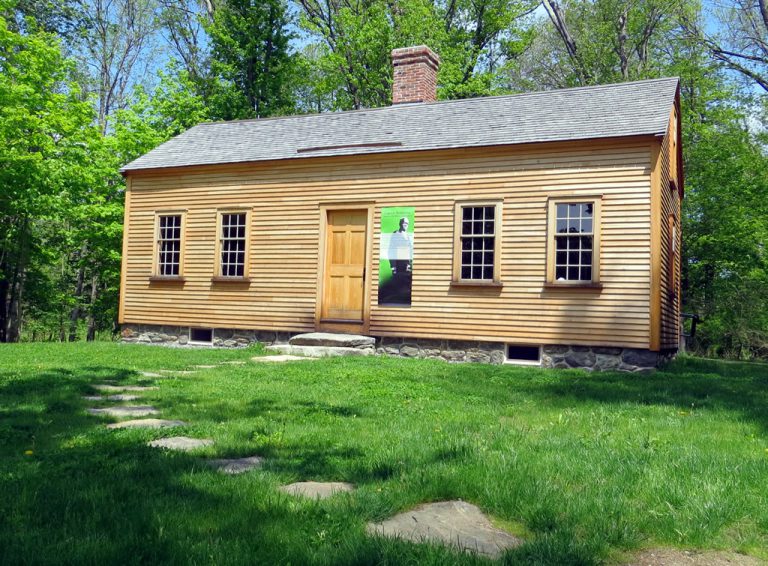
Caesar Robbins House
Reformatory Branch Trail
Returning along Monument Street toward Monument Square, look to the left to see the trailhead of the Reformatory Branch Trail, a popular hiking and biking path to Bedford MA. Laid out on a disused railway spur, the trail is unpaved and may be muddy in spots if recent days have been rainy, but if the weather has been fine, you may take it as a shortcut to Sleepy Hollow Cemetery and Authors Ridge. (See the map at the top of this page.)
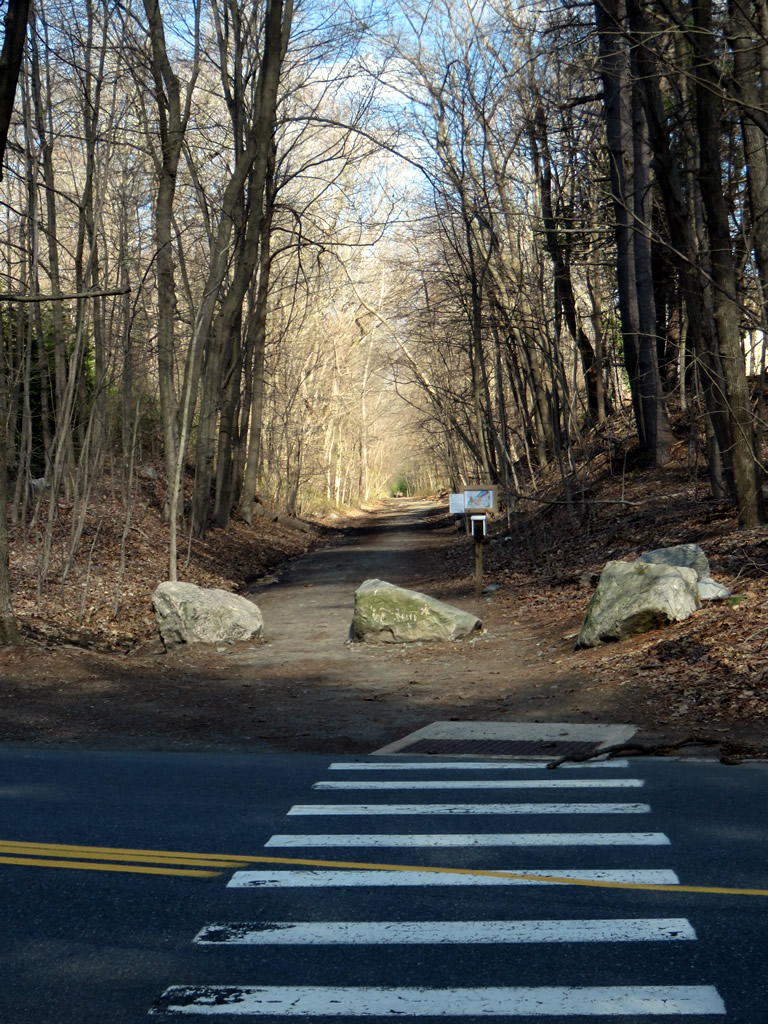
Reformatory Branch Trail
To take the shortcut, turn left (northeast) from Monument Street onto the Reformatory Branch Trail and walk through the forest to a stone monument reading “Across these fields passed the Colonial militia….”
Turn right at the monument, walk through a pine grove and across a small bridge to reach the cemetery.
As you enter the cemetery, the ridge ahead to the left above the swamp is Authors Ridge.
Stay to the left, walk up the paved road, and you’ll come to the Melvin Memorial (see below). Authors Ridge is on the other side of the ridge that rises behind the Melvin Memorial. (It is along the top of this ridge that you’ll find the grave of Daniel Chester French, the Melvin Memorial’s creator.)
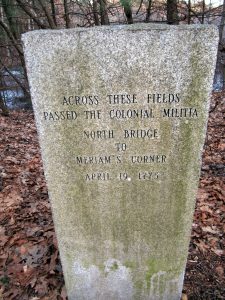
Sleepy Hollow Cemetery
Designed as an early American example of the garden cemetery, Concord’s Sleepy Hollow Cemetery was inspired by Ralph Waldo Emerson’s philosophies as well as Sir Christopher Wren’s earlier idea of designing landscaped burial grounds located outside of churchyards and city centers.
Paris’s Père Lachaise Cemetery, opened in 1804, was the first full example of Wren’s ideas, and is still a model for the best.
The first garden cemetery in the USA, and one of the finest, is Mount Auburn Cemetery (1831) in Cambridge MA.
Emerson gave the formal address at Sleepy Hollow’s dedication in 1855.
Authors Ridge holds the graves of Louisa May Alcott, Ralph Waldo Emerson, Daniel Chester French, Nathaniel Hawthorne, Henry David Thoreau, and their families.
Returning from the Old North Bridge along Monument Street, if you’re on foot and you don’t take the Reformatory Branch shortcut (mentioned above), turn left (east) on Court Lane just before Monument Square. One block along, at the intersection of Court Lane and Bedford Street, turn left into the cemetery gate. (This gate is for pedestrians. The preferred auto gate is the next one farther east along Bedford Street.) Walk east through the cemetery to the Melvin Memorial, then around the ridge behind it to Authors Ridge.
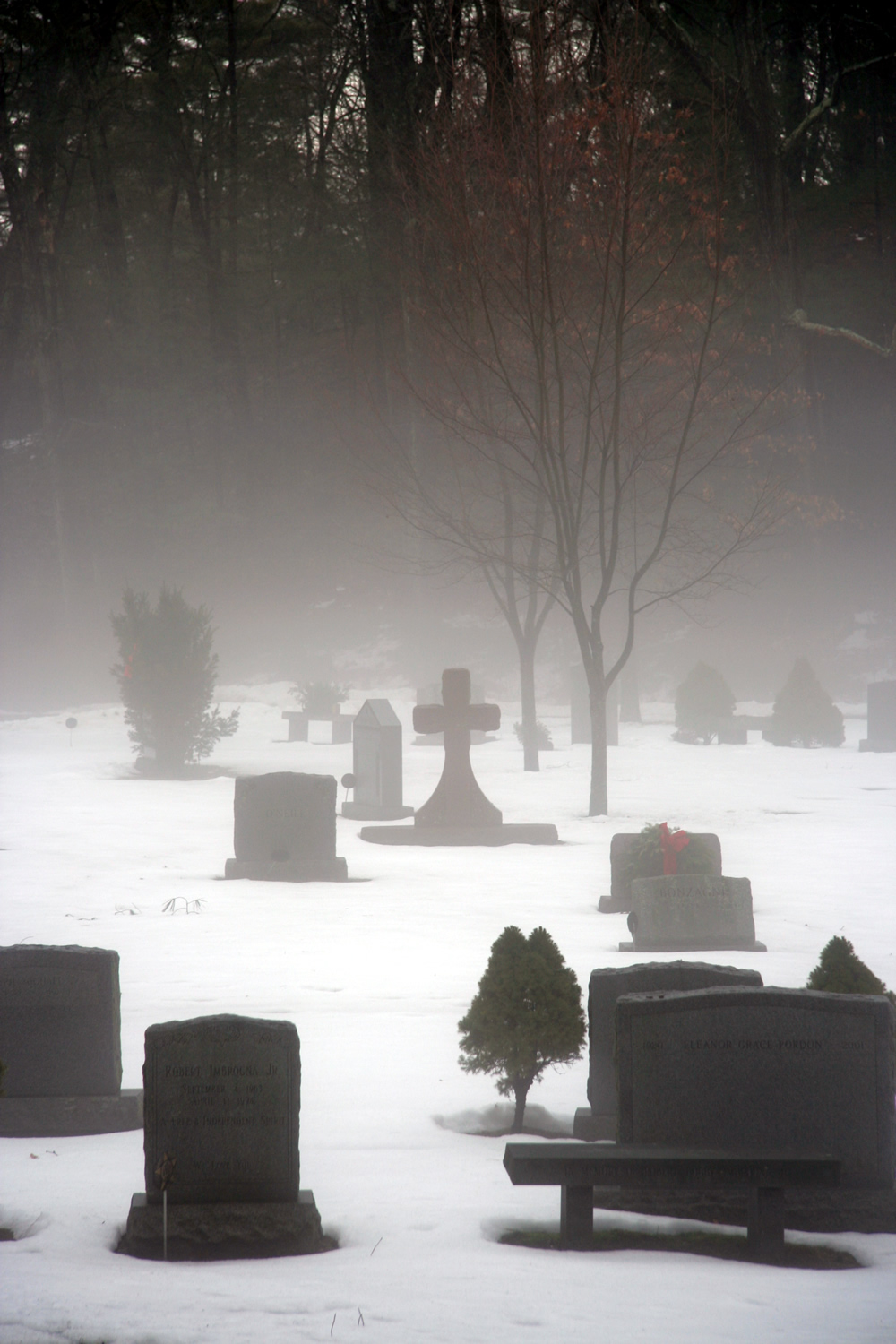
Sleepy Hollow Cemetery in winter mist
Melvin Memorial
Also worth seeing are the grave of Daniel Chester French and, nearby, his Melvin Memorial, a large, fine funerary monument featuring his Mourning Victory, executed by French in the early 1900s to honor of three brothers of the Melvin family who died in the Civil War.
Four brothers of Concord’s Melvin family went off to the Civil War. Only one returned, James C Melvin, who prospered in civilian life. In 1897 he commissioned sculptor Daniel Chester French to create a monument at the center of the planned memorial for his three lost brothers.
French sculpted the Mourning Victory, among the most eloquent of his works, in the prevailing Art Nouveau style, perfectly suited to portray the nobility of the brothers’ sentiments, the tragedy of their sacrifice, and the bittersweet poignancy of victory in the cause for which they gave their lives.
The memorial was dedicated in 1909. Having deteriorated over the 110 years since its dedication, the memorial was carefully restored in 2018, and re-dedicated on June 16, 2019.
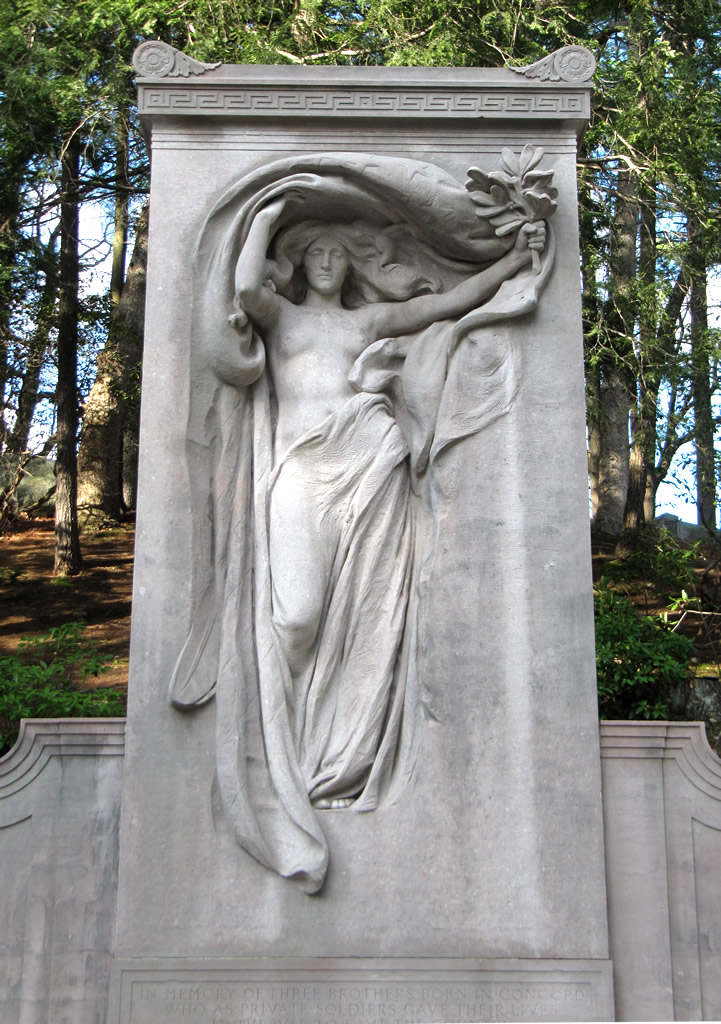
Mourning Victory, the Melvin Memorial
Authors Ridge
Look for this uphill path and the stone marker right by a small parking area.
Up the hill and to the right are the graves of the Thoreau family, including Henry David Thoreau; to the left are the graves of the Hawthornes.
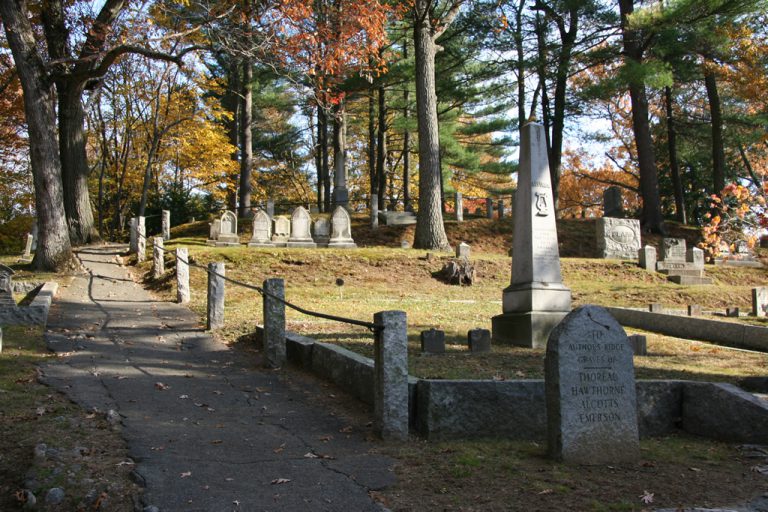
Path to Authors Ridge
Henry David Thoreau's Grave
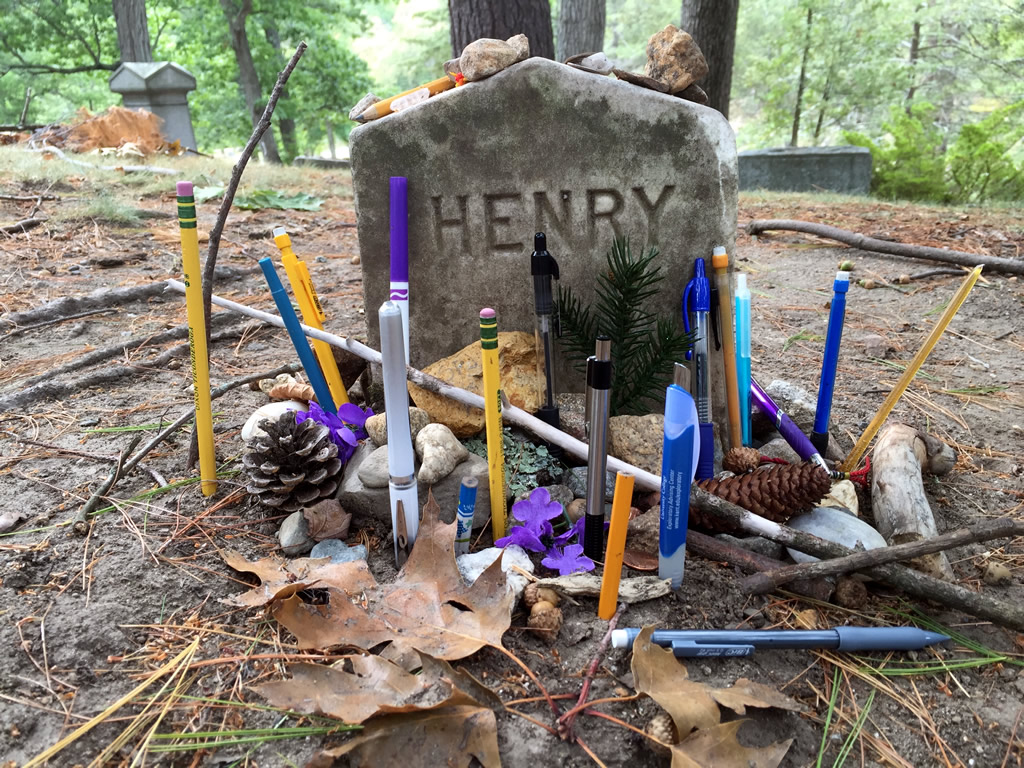
Henry’s modest tombstone is always decorated with votive offerings: pens and pencils, notes, pebbles, flowers, pine cones. The gifts left by ardent admirers are periodically cleared away.
Graves of the Hawthornes
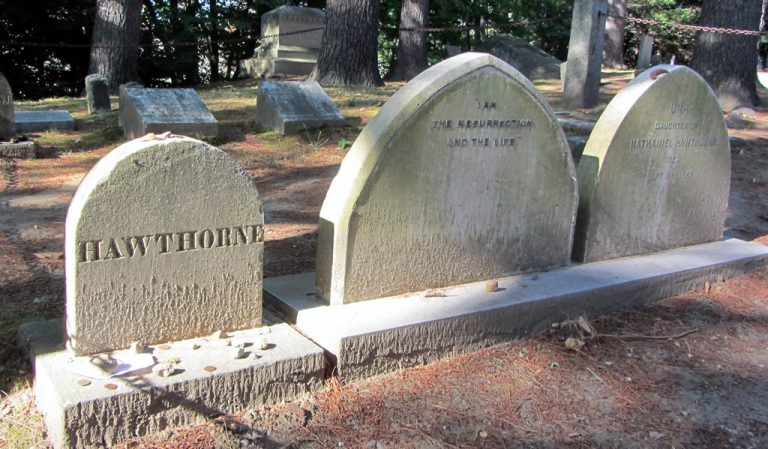
Nathaniel Hawthorne was buried here alone in 1864. Sophia Hawthorne died in London in 1871, followed by their daughter Una in 1877. Both were buried in Kensal Green. Their graves were neglected until July 26, 2006, when their remains were reinterred here next to Nathaniel.
The Alcotts' Graves
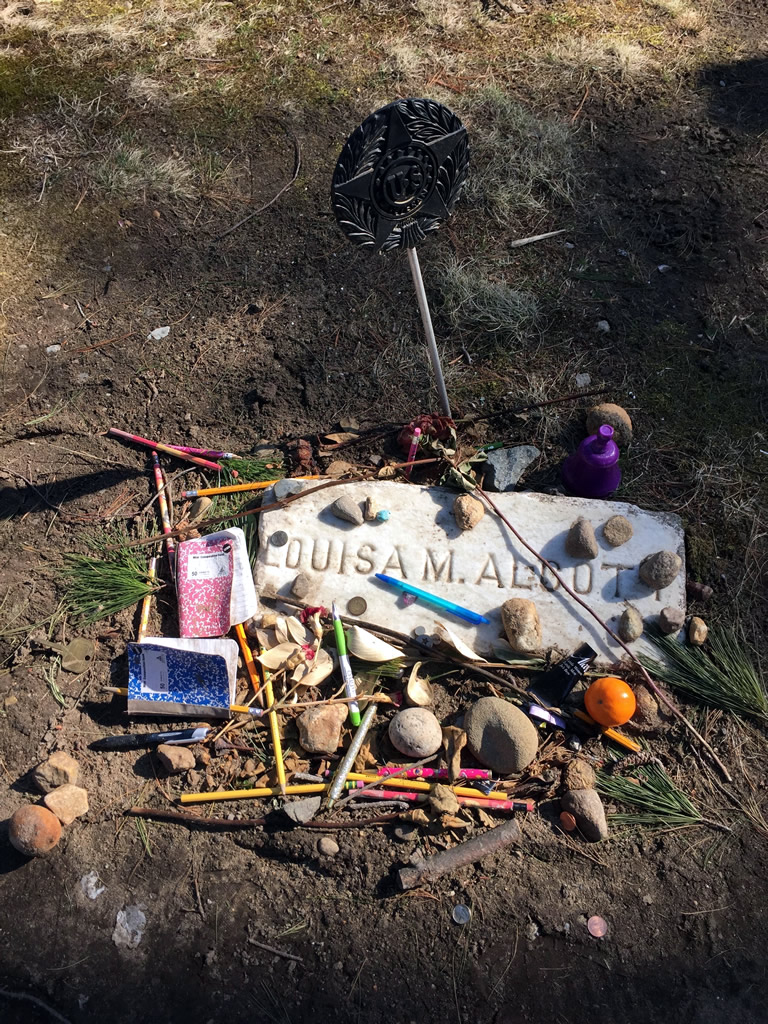
Like Henry David Thoreau’s, Louisa May Alcott’s grave receives many votive offerings. Her mother Abba, father Amos Bronson, and her sisters are buried in the family plot also.
The Emersons' Graves
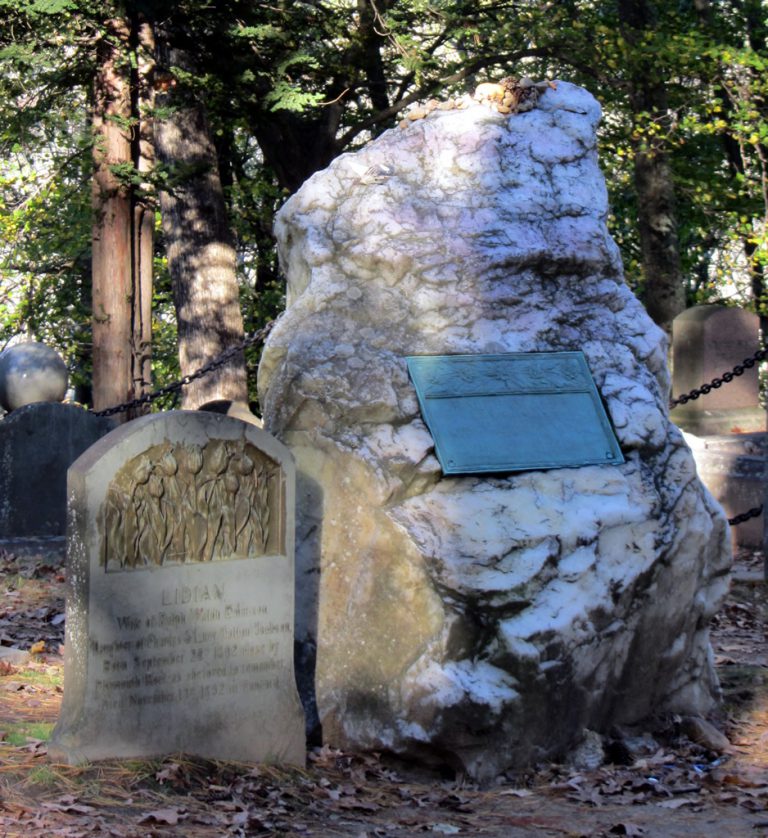
The stone on Ralph Waldo Emerson (1803-1882) grave is a huge quartzite boulder. That of Lidian Jackson Emerson (1802-1892) is a more modest stone decorated with tulips. Other family members are nearby, some with histories carved in the back of their tombstones.
Grave of Ephraim Wales Bull
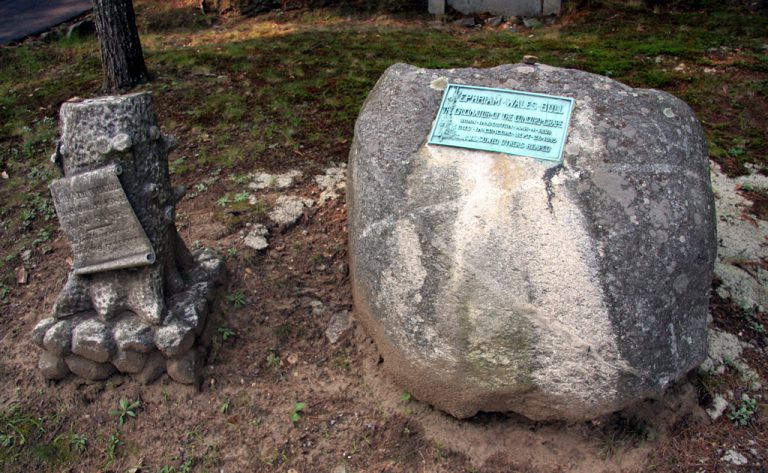
Bull (1806-1895), the “originator” of the Concord Grape, is buried just down the hill from the Emersons, along with his son, Ephraim. Note the misspelling as “Ephriam” on his plaque.

Daniel Chester French Grave
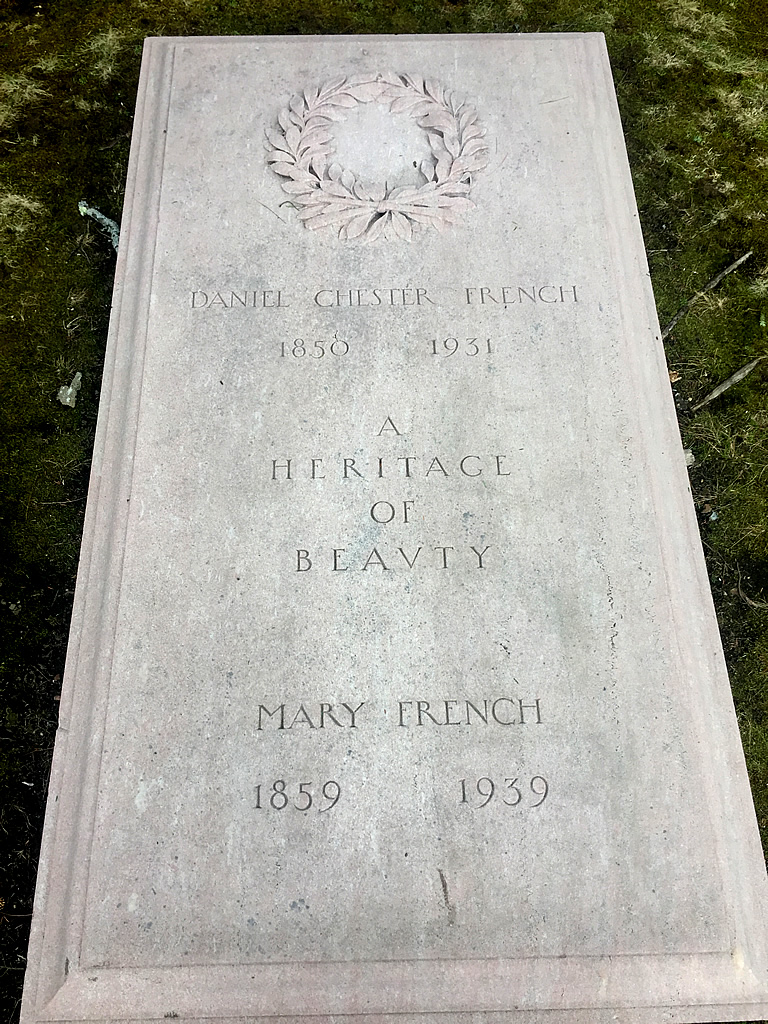
Daniel Chester French (1850-1931) and Mary French (1859-1939) are buried on the ridge between Authors Ridge and the Melvin Memorial. Visitors put pennies in the wreath with the image of the Lincoln Memorial showing, in commemoration of French’s seated Abraham Lincoln statue (1920).